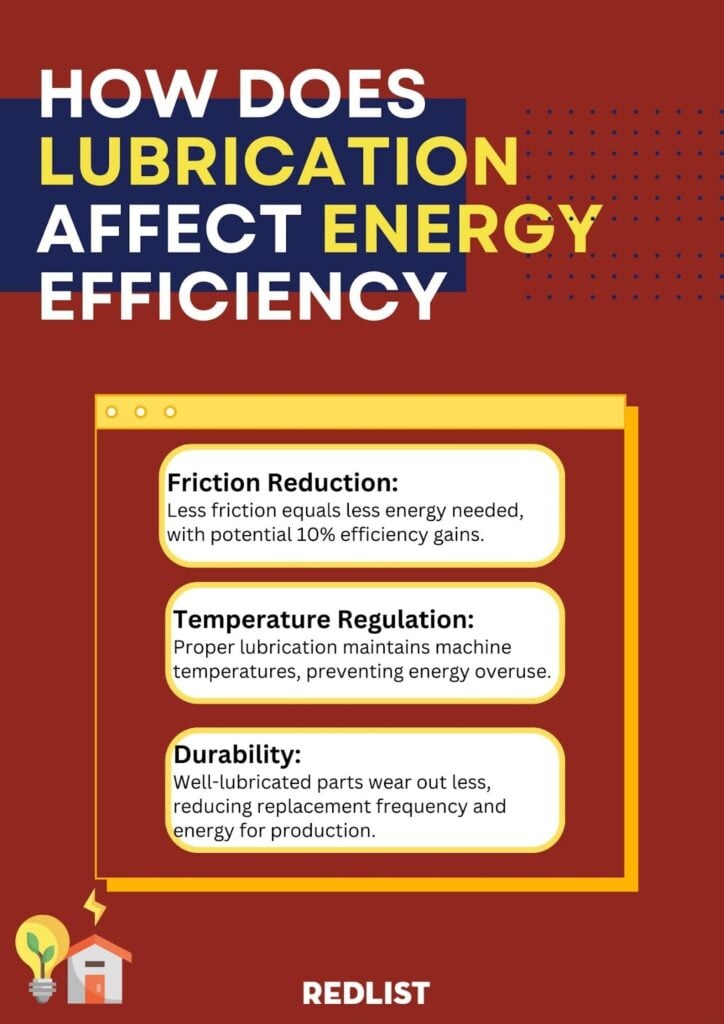Lubrication is often overlooked yet critical. It influences energy efficiency in industrial operations. Mitigating friction in machinery is pivotal for optimizing mechanical efficiency. It leads to tangible energy savings and reduced operating costs. Let’s delve into the crucial role of lubrication in industrial energy efficiency. We examine the benefits it offers and be instrumental in organizational success.
The Power of Reducing Friction
Efficient machinery performance hinges on minimizing friction and wear. Friction generates heat and results in energy wastage. This leads to escalated energy consumption and operational costs. Lubrication emerges as a key player in this scenario. It forms a protective film that separates moving parts. As a result, it prevents direct contact and minimizes wear and tear.
Strategies to Reduce Friction:
1. Regular maintenance – This ensures that machinery remains in optimal condition. Implementing a routine maintenance schedule is key. Regular inspection, cleaning, and lubrication of moving parts prevent the buildup of debris and reduce friction.
2. Proper Alignment of Machinery – Ensuring precise alignment of machinery components is crucial. Misalignment can lead to increased friction and accelerated wear. Proper alignment minimizes contact points, reducing friction and energy consumption.
3. Effective Lubrication Practices – Choosing the right lubrication method is essential. You can use oils, greases, or solid lubrication. Applying the correct lubricant in appropriate quantities forms a protective film. This reduces direct contact between moving parts and minimizes friction.
4. Solid Lubrication Technologies – use materials like graphite or molybdenum disulphide. This can be effective in reducing friction. These materials provide a durable and low-friction surface, especially in high-temperature operating conditions.
5. Advanced Monitoring Systems – Implementing sophisticated monitoring systems allows real-time tracking of machinery performance. These systems, such as those offered by companies like Redlist. They enable the proactive identification of potential friction points. They ease timely intervention and cut wear.
6. Surface Coatings Optimization – Specialized coatings reduce friction. They also enhance durability when applied to machinery surfaces. Various coatings, like polymers or ceramics, can create a smoother surface. This reduces the resistance between moving parts.
7. Balancing Loads – Distributing loads among moving components helps prevent uneven wear. It also reduces localized friction. Balancing loads ensures no single area bears excessive stress. This contributes to friction reduction.
8. Temperature Control – Managing operating temperatures is crucial to minimizing friction. High temperatures can lead to increased thermal expansion and greater friction between components. Efficient cooling systems and temperature control measures contribute to friction reduction.
9. Precision engineering – It involves designing and manufacturing machinery components with precision. This creates smoother surfaces and tighter tolerances. This reduces the likelihood of abrasive contact between moving parts, lowering friction.
10. We must train operational staff to use the equipment – We must also train them in maintenance practices. This is essential. Educated and skilled personnel are more likely to identify potential friction issues early on. They can ensure timely intervention and cut the impact on energy efficiency.
Why Lubrication Formulation Matters
The selection of an appropriate lubrication formulation holds paramount importance. Different industrial operations need specific types of lubricants. These can be oils, greases, or specialized coatings. Plant managers must consider factors such as high temperature, load, and speed. They must also take into account environmental conditions. A well-chosen lubricant reduces friction. It also enhances energy efficiency and extends machinery lifespan.
The Benefits of Energy Efficiency in Lubrication
Investing in energy efficiency reduces energy use. It also supports a greener, more sustainable future. This commitment impacts an organization’s bottom line. It results in lower energy costs and reduced operating expenses. Moreover, energy-efficient operations enhance a company’s reputation, appealing to conscious consumers.

How Redlist Can Help:
First, we’ve established the critical role of lubrication in improving energy efficiency. Now, let’s explore how Redlist can help your organization achieve its energy efficiency goals.
1. Comprehensive Data Analysis
Redlist’s software solutions offer real-time data analysis. This enables plant managers to track lubrication processes and machinery performance. Under various operating conditions, this data-driven approach maximizes energy savings by identifying areas.
2. Predictive Maintenance
Redlist’s predictive maintenance features help with proactive machinery maintenance. Performance trends serve as the basis for them, and they cut unplanned downtime. This approach extends equipment life and enhances energy efficiency in diverse operating environments.
3. Lubrication Management Tools
Redlist provides lubrication management tools that streamline organizational lubrication processes. Using the right lubricants reduces friction and energy use. This applies to solid or grease lubrication, and requires using the right amounts.
4. Energy Efficiency Reports
Redlist’s software generates comprehensive energy efficiency reports. It offers insights into the savings achieved through improved lubrication methods and practices. These reports serve as valuable documentation. They showcase the positive impact of energy efficiency initiatives on various stakeholders.
In today’s competitive industrial landscape, prioritizing energy efficiency is paramount. Lubrication is vital. It reduces friction, optimizes mechanical efficiency, and lowers energy consumption. Organizations can partner with forward-thinking companies. This partnership can bolster their energy efficiency and reduce operating costs. For example, Redlist. They can harness the power of cutting-edge software solutions.

Book a free demo today! Discover how Redlist can propel your organization toward a more energy-efficient future. It marks the initial step toward sustained growth and success.


